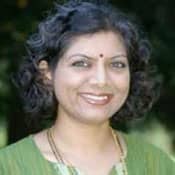I discovered that the Hindu holy day of Maha Shivarathri and Ash Wednesday are just a week apart this year and, as always, I find common ground in some Hindu and Christian practices.
Ash Wednesday marks the beginning of Lent, a season of fasting and penance, where ash might be smeared on one's forehead. Lent is about an inner transformation, a time of contemplation, waiting for what is to come. The goal is to turn one's life more completely over to Christ and His way of life, but what different denominations do during Lent varies widely. Maha Shivarathri falls on different dates every year; it's about looking inward as a means for transformation, and practices for this Hindu holy day vary by sampradaya (similar to denomination) also.
The variation in when these Hindu and Christian holy days occur, and the different rituals and practices centering on them, is the beginning of finding similarities. But first, let me offer an explanation of the Hindu calendar.
Actually, the Hindu calendar is quite difficult to explain; it could be solar, lunar, lunisolar, or astrological, and regional, ethnic, and agricultural differences may arise. The people of India, where the majority of Hindus live and hail from, use around thirty calendars, making for many different days that mark the New Year. Just starting with language communities, there are the Gujarati Hindu Vikram Samvatsar (the day after Diwali), Marathi Gudi Padwa, Malayali Vishu, and Telugu Ugadi, to name a few. There is also variation in the celebration of other Hindu holy days; songs and prayers are often centered on different Gods/aspect of God. One such aspect of the divine is the Hindu trinity of Brahma, Vishnu, and Maheshwara or Shiva. Shiva itself means the auspicious one; His body is smeared with ash, He is often referred to as the God of Destruction, and He represents the power of transformation.
Maha Shivarathri is "Shiva's Great Night." It falls on the fourteenth day of the dark half of Kumbha, or Aquarius—this year on March 2. Devotees fast all day; bathe the sacred deity of Shiva (known as the Shiva Linga) with water, milk, honey, and saffron water; and chant Sri Rudram, the pre-eminent Vedic hymn to Shiva, or the 1,008 names of Shiva, chanting Om Namah Shivaya. The stotrams and bhajans, such as the Shiva Tandava Stotra, akin to hymns, are sung throughout the all-night vigil. Hindus marking the vigil contemplate and reflect, seeking to climb the Mount Kailas (the mountain abode of Shiva) within themselves, as a means to come closer to the Unmanifest Reality that Shiva represents. Devotees break their fast by eating the sacred prasadam, blessed food, offered earlier to the Lord. The following day is one of feasting and gaiety; joyfulness brings us closer to the bliss of God-realization.
We celebrate Maha Shivarathri in our family through rituals at the local Hindu temple, usually on the weekend following Maha Shivarathri; after all, we are in America and the work week doesn't stop to mark the multitude of Hindu holy days. The rituals include my favorite, a Jyotirlingarchana, where 1,008 special lamps arranged in a significant formation are lit, symbolic of the light of knowledge dispelling the darkness of ignorance. This is always followed by a program by the Bharata Natyam students who learn dance at the temple—Tandav (or Tandava). This is the cosmic dance of Shiva, a vigorous dance that is the source of the cycle of creation, preservation, and dissolution, with many dimensions, one of the most beautiful being the Ananda Tandava—Dance of Bliss.
Lent is, of course, not a time of joy, but a somber time, a time for emptying oneself and waiting for resurrection, but Shiva's Tandava has many aspects, not just the one of joy, as Shiva goes through several phases, such as Rudra Tandava, to express grief and anger. Hindu American Seva Charities Founder-Convener Anju Bhargava recently wrote of "spiritual self inquiry and discovery" in "The Importance of Seva and Social Justice for Inner Transformation."
This March, may Hindus and Christians, as they go on their similar yet different journeys of spiritual self-inquiry, discover the beauty that lies between us.
3/3/2011 5:00:00 AM





